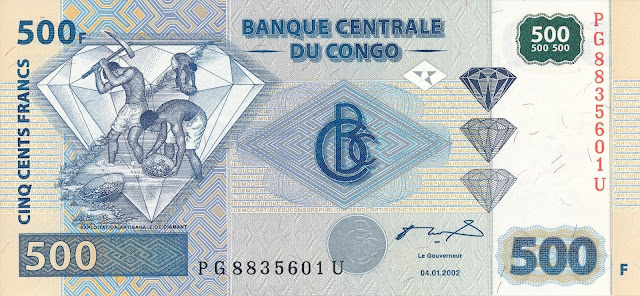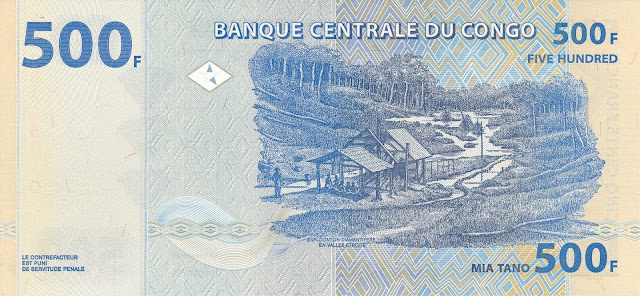Congo Democratic Republic 500 Congolese francs banknote 2002
Central Bank of the Congo - Banque Centrale du Congo
Obverse: Three diamond prospectors at work and Large Diamond at left; Monogram of the Central Bank of Congo at center; Three diamonds aligned vertically.
Reverse: Diamond exploitation in Etroite Valley.
Watermark: Single Okapi head or multiple Okapi heads repeated vertically.
Main color: Blue on multicolored underprint.
Size: 150 x 70 mm.
Printed by Giesecke & Devrient, Germany.
Dated 4. January 2002. Signature of Jean-Claude Masangu Mulongo (as LE GOUVERNEUR). Solid security thread with demetalized text. 5-pointed star as registration device. One horizontal and one vertical 7-digit serial number on front, both having a single letter prefix, a single letter suffix and numerals of the same size.
Congo Democratic Republic Banknotes and Paper Money
1997-2013 Issue
200 Congolese francs 500 Congolese francs 1000 Congolese francs
Democratic Republic of Congo and Diamonds:
Although the Democratic Republic of Congo is Africa’s largest diamond producer, production details remain sketchy. Most of the DRC’s production is produced by the informal sector. Similar to Angola, rebel forces now hold traditional diamond production areas, primarily in the Eastern Kasai province. In mid-2004 the Kimberley Process struck the country off its list of certifiable diamond producers accusing it of dealing in blood diamonds thus resulting in the DRC ceasing exports of diamonds.
In August 2004 the the body in charge of certifying minerals for export from the Democratic Republic of Congo announced that it was setting up three branches in formerly rebel-held areas to combat the trade in so-called blood diamonds. The Centre for Evaluation, Expert Analysis and Certification of Precious Minerals (CEEC) plans to establish offices in Goma, Bukavu and Kisangani in the eastern part of the country. The minister for mines, Eugene Diomi Ndongala estimated that the Congolese treasury loses around $450 million a year because of diamond smuggling.
The only commercial diamond producer in DRC is Miniere de Bakwange (MIBA), which is a joint venture between Belgian company Sibeka and the DRC government, which owns 80%. De Beers holds a 20% stake in Sibeka (Belgian Umicore the remaining 80%), and markets about one third of the country’s diamonds. The company owns the only functioning mine in the country. MIBA has struggled to keep production levels constant due to problems in locating suitable buyers and markets. Apart from that, the company is also facing depleted alluvial reserves, coupled with the fact that there is limited funding to evaluate and exploit existing kimberlite resources. MIBA produced approximately 9 Mct in 2000, although these figures are expected to fluctuate due political tension in the Kasai region.
As it stands, diamond mining in the country has taken place on a small scale and a considerably small area has been explored using modern technology. There has been renewed interest by the international mining industry in the DRC as a result of the 2003 implementation of the new DRC Mining Code, which was drafted in conjunction with the World Bank. The Mining Code provides the PR holder with broad access to explore its properties under a transparent and efficient permitting process. In the case of diamond exploration, the Mining Code gives the PR holder exclusive rights for a period of four years, renewable for two additional two-year periods. On discovery of an economically viable deposit, the holder can apply for a Permit of Exploitation.
During September 2004 De Beers signed a confedentiality report with Oryx Natural Resources as part of a due diligence exercise for the possible development of Sengamines diamond concession in the Democratic Republic of Congo. De Beers has started surveying the area which is expected to have significant potential and requires an estimated US$200 million to be brought into production.
In September 2004 BRC Diamond Corporation received confirmation of title for 13 Prospecting Research Permits (“PRs”) for diamonds in the Lubao district of the Democratic Republic of the Congo. The properties, which represent a surface area of approximately 4900 km2, are located in Kasai-Oriental, historically the largest diamond producing region of the DRC. Some of these areas are highly prospective diamond opportunities, which have never been systematically explored.
Since 2003, Southern Era has secured an excellent portfolio of exclusive diamond exploration permits covering 13,614 square kilometers located within the diamond-rich Kasai Province of the DRC. The majority of permits lie within a ‘kimberlite emplacement corridor’, underlain by Archean basement granite-gneiss of the Congo Craton, which extends from the DRC southwest into the renowned diamond producing Lunda Norte Province in neighboring Angola. This kimberlite emplacement corridor is considered the world’s most prospective and largest new exploration opportunity.
It is estimated that roughly a third of the DRC’s production is smuggled out of the country every year. Canadian Wye Resources have some alluvial diamond concessions in the Kasai Occidental Province. The country currently has 700000 artisanal diamond miners.

